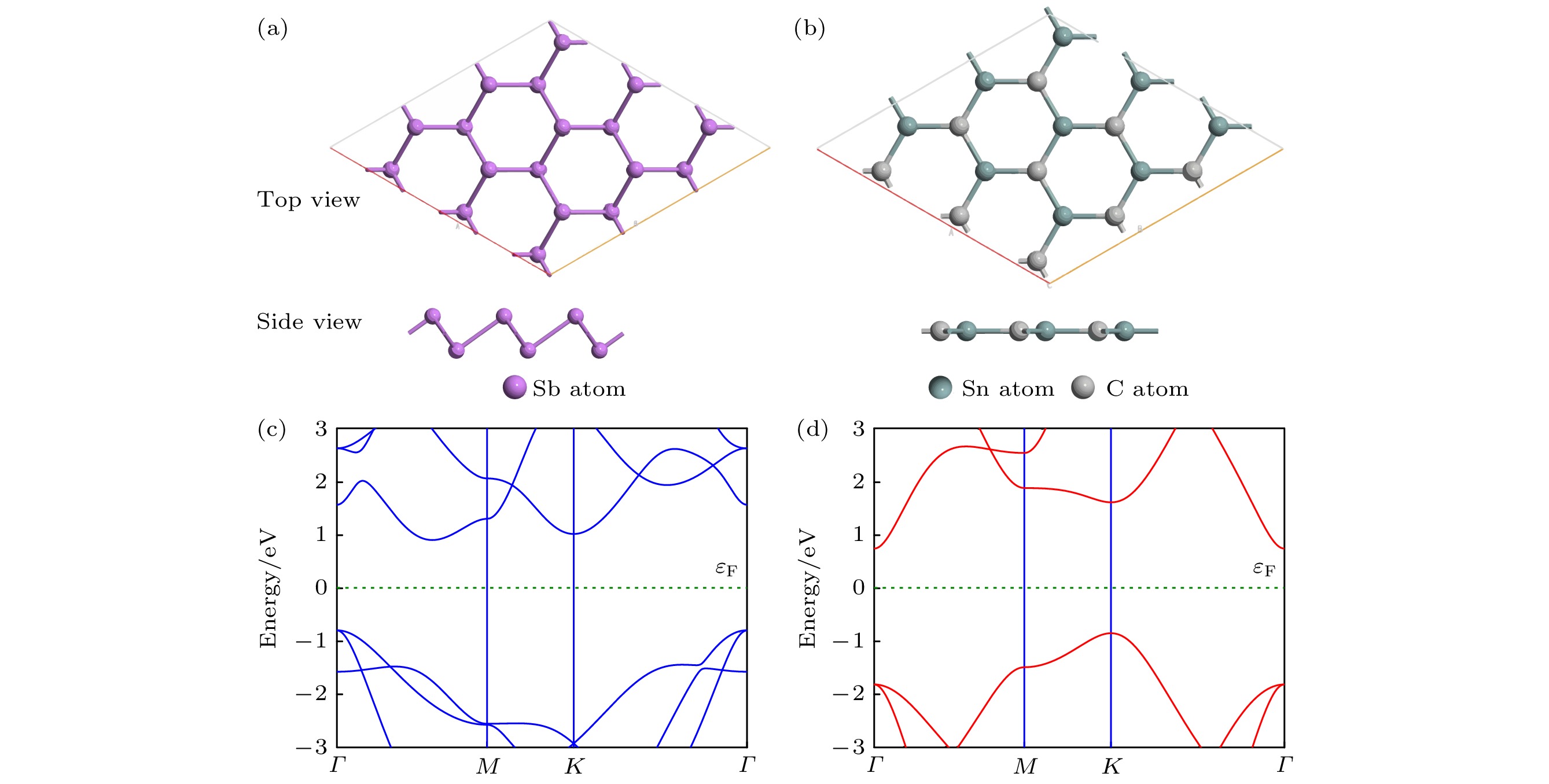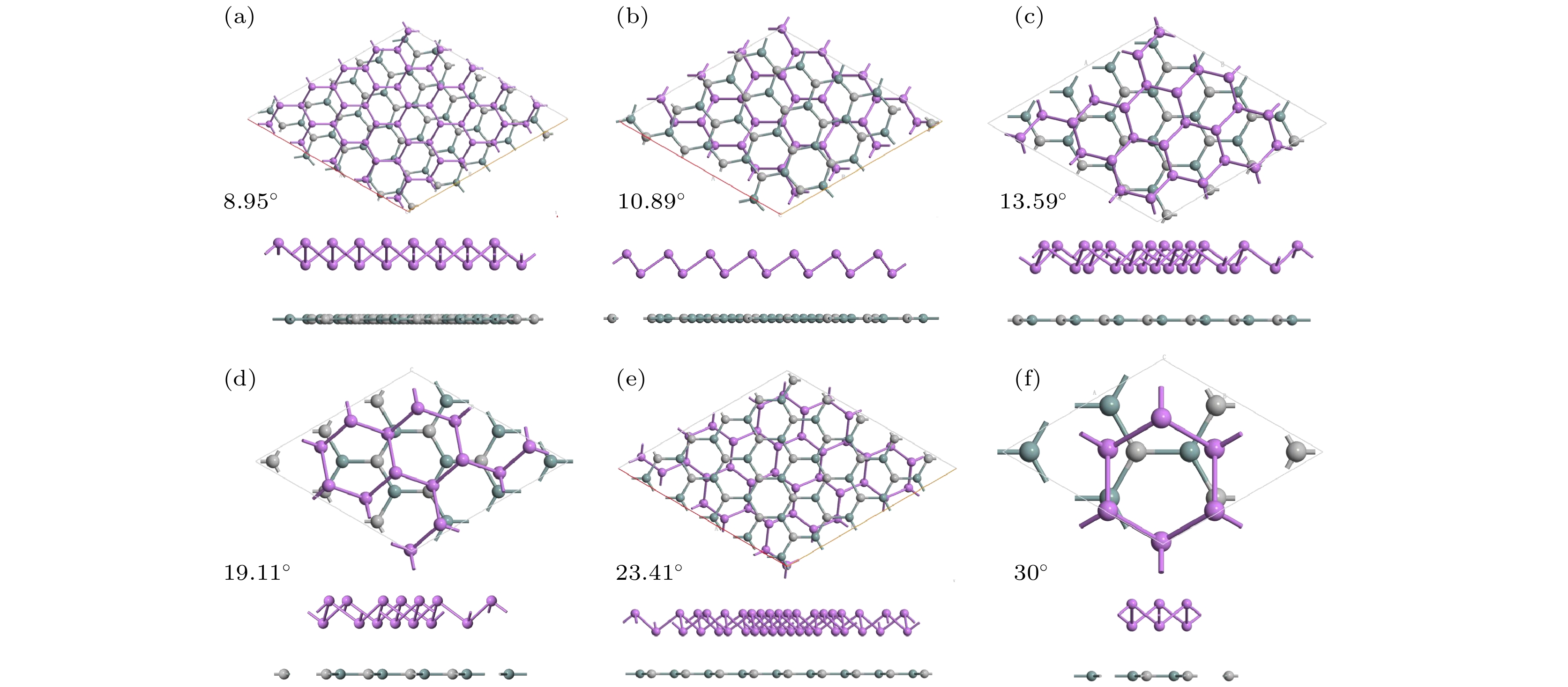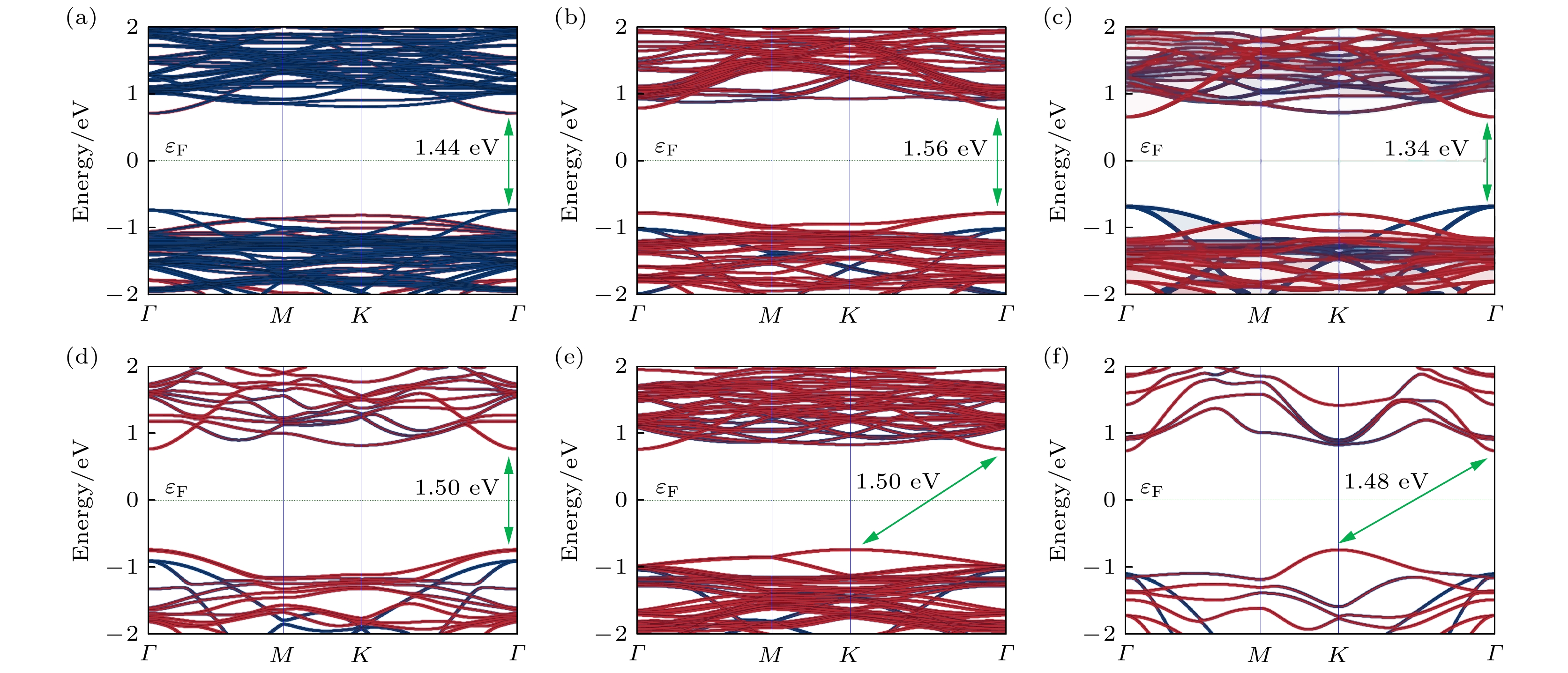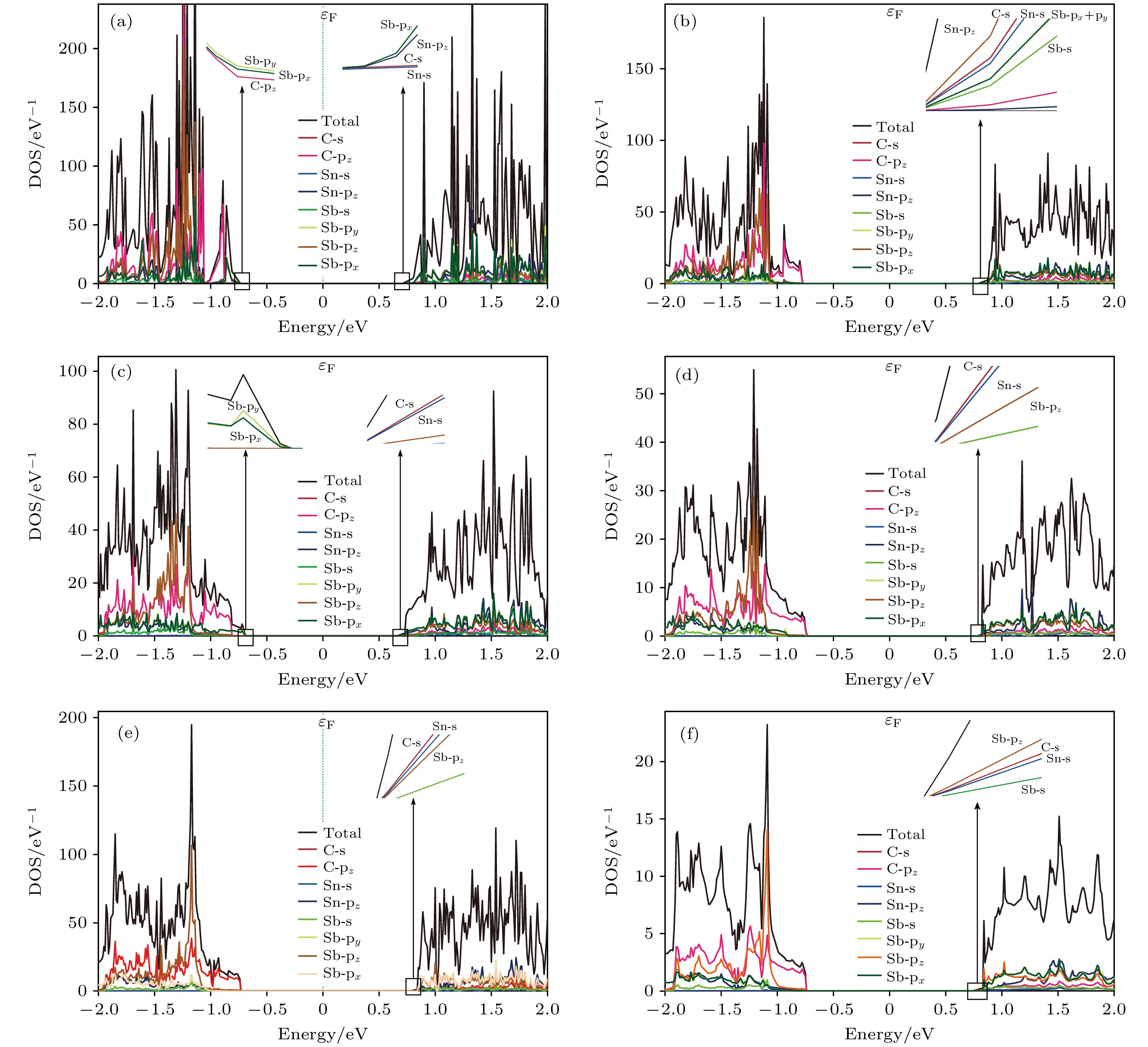-
基于二维锡基材料与锑烯单层构建了具有不同层间转角的6种Sb/SnC二维范德瓦耳斯异质结, 并根据第一性原理对其光电性质及应用开展研究. 研究结果表明, 6种层间转角的Sb/SnC异质结具有不同的带隙, 且当层间转角为10.89°, 19.11°, 23.41°和30°时, Sb/SnC异质结显示出I型能带结构, 而当层间转角为8.95°和13.59°时, 则是II型能带结构. 同时, 6种异质结的轨道投影带结构表明, 由于层间转角改变了异质结的原子堆叠方式, 从而改变了轨道耦合并进一步调控了异质结的电子结构. 此外, 吸收谱的计算表明, 与Sb和SnC单层相比, 异质结的光吸收系数在可见光区域得到显著增强, 且对应不同的层间转角, 异质结的光吸收特性差异明显. 在应用方面, 作为太阳能电池材料, 层间转角为8.95°和13.59°的Sb/SnC异质结分别具有17.48%和18.59%的光电转化效率; 作为全解水光催化剂, 层间转角为8.95°的异质结可对pH值为0—2的水完全催化分解, 而层间转角为13.59°的异质结仅可以对pH值为0—1的水进行催化分解. 因此, 作为一个重要的结构参数, 层间转角可以有效地调控Sb/SnC异质结的光电特性, 具有特定转角的Sb/SnC异质结可在太阳能和光催化领域获得应用.The discovery of novel properties in twisted bilayer graphene has opened up new avenues of research in physics and materials science, making the twistronics a new research hotspot. In this paper, based on two-dimensional tin-based materials and antimonene monolayers, six types of Sb/SnC two-dimensional van der Waals heterostructures (vdWH) with different interlayer twist angles are constructed, and their optoelectronic properties and applications are studied by first-principles calculations. All modeling and calculations are performed using the density functional theory (DFT) software Quantum-ATK. The results show that the Sb/SnC vdWHs with six different interlayer twist angles have various band gaps, and when the interlayer twist angles are 10.89°, 19.11°, 23.41°, and 30°, the Sb/SnC vdWH exhibit a type-I band edge alignment, while at 8.95° and 13.59°, they present a type-II band structure. The results of the orbital-projected band structures of the Sb/SnC vdWHs reveal that the variation in interlayer twist angles changes the atomic stacking in the heterostructures, thereby modifying orbital coupling and further tuning the electronic structure of the heterostructures. Additionally, the calculated absorption spectra indicate that comparing individual Sb and SnC monolayers with Sb/SnC vdWHs, the latter’s absorption coefficient r is significantly enhanced in the visible light region, and the optical absorption characteristics of the heterostructures with different interlayer twist angles vary markedly. In terms of applications, as materials for solar cells, the Sb/SnC vdWHs with interlayer twist angles of 8.95° and 13.59° exhibit photovoltaic conversion efficiencies of 17.48% and 18.59%, respectively; as photocatalysts for the complete water splitting, the Sb/SnC vdWH with an interlayer twist angle of 8.95° can catalytically decompose water across a pH range of 0–2, while a twist angle of 13.59° confines its catalytic activity to a pH value between 0 and 1. Therefore, Sb/SnC van der Waals heterostructures have special rotation angles and have multifunctional application prospects in the fields of solar energy and photocatalysis. More importantly, our research demonstrates that in addition to traditional methods such as strain, doping, and defects, adjusting the interlayer twist angle provides a new degree of freedom for manipulating the optoelectronic properties of materials.
-
Keywords:
- van der Waals heterojunction /
- first principles /
- photoelectric characteristics /
- interlayer rotation angle
[1] Cao Y, Fatemi V, Fang S A, Watanabe K, Taniguchi T, Kaxiras E, Jarillo-Herrero P 2018 Nature 556 43
 Google Scholar
Google Scholar
[2] Carr S, Massatt D, Fang S A, Cazeaux P, Luskin M, Kaxiras E 2017 Phys. Rev. B 95 075420
 Google Scholar
Google Scholar
[3] Carr S, Fang S A, Kaxiras E 2020 Nat. Rev. Mater. 5 748
 Google Scholar
Google Scholar
[4] Cao Y, Fatemi V, Demir A, Fang S, Tomarken S L, Luo J Y, Sanchez-Yamagishi J D, Watanabe K, Taniguchi T, Kaxiras E, Ashoori R C, Jarillo-Herrero P 2018 Nature 556 80
 Google Scholar
Google Scholar
[5] Ren Y N, Zhang Y, Liu Y W, He L 2020 Chin. Phys. B 29 117303
 Google Scholar
Google Scholar
[6] Choi Y, Kim H, Peng Y, Thomson A, Lewandowski C, Polski R, Zhang Y, Arora H S, Watanabe K, Taniguchi T, Alicea J, Nadj-Perge S 2021 Nature 589 536
 Google Scholar
Google Scholar
[7] Koshino M 2019 Phys. Rev. B 99 235406
 Google Scholar
Google Scholar
[8] Ninno G De, Wätzel J, Ribič P R, Allaria E, Coreno M, Danailov M B, David C, Demidovich A, Di Fraia M, Giannessi L, Hansen K, Krušič Š, Manfredda M, Meyer M, Mihelič A, Mirian N, Plekan O, Ressel B, Rösner B, Simoncig A, Spampinati S, Stupar M, Žitnik M, Zangrando M, Callegari C, Berakdar J 2020 Nat. Photon. 14 554
 Google Scholar
Google Scholar
[9] Tebyetekerwa M, Truong T N, Yan W, Tang C, Wibowo A A, Bullock J, Du A, Yan C, Macdonald D, Nguyen H T 2022 Adv. Mat. Inter. 9 2201649
 Google Scholar
Google Scholar
[10] Liu B Y, Zhang Y T, Qiao R X, Shi R C, Li Y H, Guo Q L, Li J D, Li X M, Wang L, Qi J J, Du S X, Ren X G, Liu K H, Gao P, Zhang Y Y 2023 Phys. Rev. Lett. 131 016201
 Google Scholar
Google Scholar
[11] Foutty B A, Kometter C R, Devakul T, Reddy A P, Watanabe K, Taniguchi T, Fu L, Feldman B E 2024 Science 384 343
 Google Scholar
Google Scholar
[12] Hidalgo F, Sánchez-Ochoa F, Noguez C 2023 npj 2D Mater. Appl. 7 40
 Google Scholar
Google Scholar
[13] Fadaie M, Shahtahmassebi N, Roknabad M R, Gulseren O 2017 Comput. Mater. Sci. 137 208
 Google Scholar
Google Scholar
[14] Dai Z N, Cao Y, Yin W J, Sheng W, Xu Y 2022 J. Phys. D: Appl. Phys. 55 315503
 Google Scholar
Google Scholar
[15] Jiang X X, Gao Q, Xu X H, Xu G, Li D M, Cui B, Liu D S, Qu F Y 2021 Phys. Chem. Chem. Phys. 23 21641
 Google Scholar
Google Scholar
[16] Niu T C, Meng Q L, Zhou D C, Si N, Zhai S W, Hao X M, Zhou M, Fuchs H 2020 Adv. Mater. 32 1906873
 Google Scholar
Google Scholar
[17] Sun S, Yang T, Luo Y Z, Gou J, Huang Y L, Gu C D, Ma Z R, Lian X, Duan S S, Wee A T S, Lai M, Zhang J L, Feng Y P, Chen W 2020 J. Phys. Chem. Lett. 11 8976
 Google Scholar
Google Scholar
[18] Zhang S L, Yan Z, Li Y F, Chen Z F, Zeng H B 2015 Angew. Chem. Int. Ed. Engl. 54 3112
 Google Scholar
Google Scholar
[19] Singh D, Gupta S K, Sonvane Y, Lukačević I 2016 J. Mater. Chem. C 4 6386
 Google Scholar
Google Scholar
[20] Shakil M, Rehman A, Nabi G, Tanveer M, Gillani S, Al-Buriahi M S, Tamam N, Alrowaili Z A 2023 Physica B: Condens. Matter 670 415389
 Google Scholar
Google Scholar
[21] Zheng K, Cui H P, Yu J B, Chen X P 2022 IEEE T. Electron Dev. 69 1155
 Google Scholar
Google Scholar
[22] Wang X, Quhe R, Cui W, Zhi Y, Huang Y, An Y, Dai X, Tang Y, Chen W, Wu Z, Tang W 2018 Carbon 129 738
 Google Scholar
Google Scholar
[23] Smidstrup S, Markussen T, Vancraeyveld P, Wellendorff J, Schneider J, Gunst T, Verstichel B, Stradi D, Khomyakov P A, Vej-Hansen U G, Lee M E, Chill S T, Rasmussen F, Penazzi G, Corsetti F, Ojanperä A, Jensen K, Palsgaard M L N, Martinez U, Blom A, Brandbyge M, Stokbro K 2020 J. Phys. Condens. Matter 32 15901
 Google Scholar
Google Scholar
[24] Perdew J P, Burke K, Ernzerhof M 1996 Phys. Rev. Lett. 77 3865
 Google Scholar
Google Scholar
[25] Vydrov O A, Heyd J, Krukau A V, Scuseria G E 2006 J. Chem. Phys. 125 74106
 Google Scholar
Google Scholar
[26] Grimme S 2006 J. Comput. Chem. 27 1787
 Google Scholar
Google Scholar
[27] Chen H L, Han J N, Deng X Q, Fan Z Q, Sun L, Zhang Z H 2022 Appl. Surf. Sci. 598 153756
 Google Scholar
Google Scholar
[28] Tan X Y, Liu L L, Ren D H 2020 Chin. Phys. B 29 76102
 Google Scholar
Google Scholar
[29] Jelver L, Larsen P M, Stradi D, Stokbro K, Jacobsen K W 2017 Phys. Rev. B 96 085306
 Google Scholar
Google Scholar
[30] Deng S, Zhang Y, Li L 2019 Appl. Surf. Sci. 476 308
 Google Scholar
Google Scholar
[31] Wang F F, Yuan J, Zhang Z F, Ding X L, Gu C J, Yan S B, Sun J H, Jiang T, Wu Y F, Zhou J 2023 Phys. Rev. B 108 075416
 Google Scholar
Google Scholar
[32] Jiang X X, Xie W L, Xu X H, Gao Q, Li D M, Cui B, Liu D S, Qu F Y 2022 Nanoscale 14 7292
 Google Scholar
Google Scholar
[33] Scharber M C, Mühlbacher D, Koppe M, Denk P, Waldauf C, Heeger A J, Brabec C J 2006 Adv. Mater. 18 789
 Google Scholar
Google Scholar
[34] Mao Y L, Qin C Q, Wang J, Yuan J M 2022 Phys. Chem. Chem. Phys. 24 16058
 Google Scholar
Google Scholar
[35] Ahammed R, Rawat A, Jena N, Dimple, Mohanta M K, Sarkar A D 2020 Appl. Surf. Sci. 499 143894
 Google Scholar
Google Scholar
[36] Lv X S, Wei W, Mu C, Huang B B, Dai Y 2018 J. Mater. Chem. A 6 5032
 Google Scholar
Google Scholar
[37] Lin P, Xu N S, Tan X L, Yang X H, Xiong R, Wen C L, Wu B, Lin Q L, Sa B S 2022 RSC Adv. 12 998
 Google Scholar
Google Scholar
[38] Shi L, Xu W P, Qiu X, Xiao X L, Wei H R, Duan Y H, Wang R, Fan J, Wu X Z 2023 Appl. Phy. Lett. 123 131102
 Google Scholar
Google Scholar
[39] Navarro Yerga Rufino M, Alvarez Galván M Consuelo, del Valle F, Villoria de la Mano José A, Fierro José L G 2009 Chem. Sus. Chem. 2 471
 Google Scholar
Google Scholar
[40] Wang Y Q, Zhang R R, Li J B, Li L L, Lin S W 2014 Nanoscale Res. Lett. 9 46
 Google Scholar
Google Scholar
[41] Chakrapani V, Angus J C, Anderson A B, Wolter S D, Stoner B R, Sumanasekera G U 2007 Science 318 1424
 Google Scholar
Google Scholar
[42] Zhao Z, Yang C, Cao Z, Bian Y, Li B, Wei Y 2022 Spectrochim. Acta Part A. 278 121359
 Google Scholar
Google Scholar
[43] Zhang W X, Hou J T, Bai M, He C, Wen J R 2023 Chin. Chem. Lett. 34 108270
 Google Scholar
Google Scholar
[44] Luo Y, Ren K, Wang S K, Chou J P, Yu J, Sun Z M, Sun M L 2019 J. Phys. Chem. C 123 22742
 Google Scholar
Google Scholar
[45] Sutter P, Ibragimova R, Komsa H P, Parkinson B A, Sutter E 2019 Nat. Commun. 10 5528
 Google Scholar
Google Scholar
[46] Yuan L, Zheng B Y, Kunstmann J, Brumme T, Kuc A B, Ma C, Deng S B, Blach D, Pan A L, Huang L B 2020 Nat. Mater. 19 617
 Google Scholar
Google Scholar
[47] Molaei M J, Younas M, Rezakazemi M 2022 Mater. Sci. Eng. B 285 115936
 Google Scholar
Google Scholar
-
图 6 Sb, SnC及Sb/SnC异质结的价带顶和导带底的电位. 绿色(紫色)实线和虚线分别表示pH为0(2)时, 水分解的标准氧化电位和还原电位
Fig. 6. Potential of valence band maximum and conduction band minimum of Sb, SnC, and Sb/SnC vdWH. The green (purple) solid line and dashed line represent the standard oxidation potential and reduction potential of water decomposition at a pH of 0(2), respectively.
表 1 六种层间转角的Sb/SnC异质结的结构信息
Table 1. Structure information of Sb/SnC vdWH with six interlayer rotation angles.
旋转角 8.95° 10.89° 13.59° 19.11° 23.41° 30° Sb超胞 $ 5\times 5 $ $ 4\times 4 $ $ \sqrt{13}\times \sqrt{13} $ $ \sqrt{7}\times \sqrt{7} $ $ \sqrt{19}\times \sqrt{19} $ $ \sqrt{3}\times \sqrt{3} $ SnC超胞 $ \sqrt{31}\times \sqrt{31} $ $ \sqrt{21}\times \sqrt{21} $ $ 4\times 4 $ $ 3\times 3 $ $ 5\times 5 $ $ 2\times 2 $ 原子数 112 74 58 32 88 14 应变 0.99% 0.91% 1.2% 0.23% 0.99% 1.4% 层间距/Å 3.2 3.26 3.46 3.41 3.31 3.38 Eb/meV –79.4 –80.6 –76.6 –80.0 –79.3 –80.2 表 2 多种二维范德瓦耳斯异质结的光电转换效率
Table 2. Power conversion efficiency of some 2D van der Waals heterostructures.
表 3 多种II型范德瓦耳斯异质结的带隙以及在红外和可见光区的吸收系数最大值
Table 3. Band gap and the maximum absorption coefficients in infrared and visible region of some type-II van der Waals heterostructures.
-
[1] Cao Y, Fatemi V, Fang S A, Watanabe K, Taniguchi T, Kaxiras E, Jarillo-Herrero P 2018 Nature 556 43
 Google Scholar
Google Scholar
[2] Carr S, Massatt D, Fang S A, Cazeaux P, Luskin M, Kaxiras E 2017 Phys. Rev. B 95 075420
 Google Scholar
Google Scholar
[3] Carr S, Fang S A, Kaxiras E 2020 Nat. Rev. Mater. 5 748
 Google Scholar
Google Scholar
[4] Cao Y, Fatemi V, Demir A, Fang S, Tomarken S L, Luo J Y, Sanchez-Yamagishi J D, Watanabe K, Taniguchi T, Kaxiras E, Ashoori R C, Jarillo-Herrero P 2018 Nature 556 80
 Google Scholar
Google Scholar
[5] Ren Y N, Zhang Y, Liu Y W, He L 2020 Chin. Phys. B 29 117303
 Google Scholar
Google Scholar
[6] Choi Y, Kim H, Peng Y, Thomson A, Lewandowski C, Polski R, Zhang Y, Arora H S, Watanabe K, Taniguchi T, Alicea J, Nadj-Perge S 2021 Nature 589 536
 Google Scholar
Google Scholar
[7] Koshino M 2019 Phys. Rev. B 99 235406
 Google Scholar
Google Scholar
[8] Ninno G De, Wätzel J, Ribič P R, Allaria E, Coreno M, Danailov M B, David C, Demidovich A, Di Fraia M, Giannessi L, Hansen K, Krušič Š, Manfredda M, Meyer M, Mihelič A, Mirian N, Plekan O, Ressel B, Rösner B, Simoncig A, Spampinati S, Stupar M, Žitnik M, Zangrando M, Callegari C, Berakdar J 2020 Nat. Photon. 14 554
 Google Scholar
Google Scholar
[9] Tebyetekerwa M, Truong T N, Yan W, Tang C, Wibowo A A, Bullock J, Du A, Yan C, Macdonald D, Nguyen H T 2022 Adv. Mat. Inter. 9 2201649
 Google Scholar
Google Scholar
[10] Liu B Y, Zhang Y T, Qiao R X, Shi R C, Li Y H, Guo Q L, Li J D, Li X M, Wang L, Qi J J, Du S X, Ren X G, Liu K H, Gao P, Zhang Y Y 2023 Phys. Rev. Lett. 131 016201
 Google Scholar
Google Scholar
[11] Foutty B A, Kometter C R, Devakul T, Reddy A P, Watanabe K, Taniguchi T, Fu L, Feldman B E 2024 Science 384 343
 Google Scholar
Google Scholar
[12] Hidalgo F, Sánchez-Ochoa F, Noguez C 2023 npj 2D Mater. Appl. 7 40
 Google Scholar
Google Scholar
[13] Fadaie M, Shahtahmassebi N, Roknabad M R, Gulseren O 2017 Comput. Mater. Sci. 137 208
 Google Scholar
Google Scholar
[14] Dai Z N, Cao Y, Yin W J, Sheng W, Xu Y 2022 J. Phys. D: Appl. Phys. 55 315503
 Google Scholar
Google Scholar
[15] Jiang X X, Gao Q, Xu X H, Xu G, Li D M, Cui B, Liu D S, Qu F Y 2021 Phys. Chem. Chem. Phys. 23 21641
 Google Scholar
Google Scholar
[16] Niu T C, Meng Q L, Zhou D C, Si N, Zhai S W, Hao X M, Zhou M, Fuchs H 2020 Adv. Mater. 32 1906873
 Google Scholar
Google Scholar
[17] Sun S, Yang T, Luo Y Z, Gou J, Huang Y L, Gu C D, Ma Z R, Lian X, Duan S S, Wee A T S, Lai M, Zhang J L, Feng Y P, Chen W 2020 J. Phys. Chem. Lett. 11 8976
 Google Scholar
Google Scholar
[18] Zhang S L, Yan Z, Li Y F, Chen Z F, Zeng H B 2015 Angew. Chem. Int. Ed. Engl. 54 3112
 Google Scholar
Google Scholar
[19] Singh D, Gupta S K, Sonvane Y, Lukačević I 2016 J. Mater. Chem. C 4 6386
 Google Scholar
Google Scholar
[20] Shakil M, Rehman A, Nabi G, Tanveer M, Gillani S, Al-Buriahi M S, Tamam N, Alrowaili Z A 2023 Physica B: Condens. Matter 670 415389
 Google Scholar
Google Scholar
[21] Zheng K, Cui H P, Yu J B, Chen X P 2022 IEEE T. Electron Dev. 69 1155
 Google Scholar
Google Scholar
[22] Wang X, Quhe R, Cui W, Zhi Y, Huang Y, An Y, Dai X, Tang Y, Chen W, Wu Z, Tang W 2018 Carbon 129 738
 Google Scholar
Google Scholar
[23] Smidstrup S, Markussen T, Vancraeyveld P, Wellendorff J, Schneider J, Gunst T, Verstichel B, Stradi D, Khomyakov P A, Vej-Hansen U G, Lee M E, Chill S T, Rasmussen F, Penazzi G, Corsetti F, Ojanperä A, Jensen K, Palsgaard M L N, Martinez U, Blom A, Brandbyge M, Stokbro K 2020 J. Phys. Condens. Matter 32 15901
 Google Scholar
Google Scholar
[24] Perdew J P, Burke K, Ernzerhof M 1996 Phys. Rev. Lett. 77 3865
 Google Scholar
Google Scholar
[25] Vydrov O A, Heyd J, Krukau A V, Scuseria G E 2006 J. Chem. Phys. 125 74106
 Google Scholar
Google Scholar
[26] Grimme S 2006 J. Comput. Chem. 27 1787
 Google Scholar
Google Scholar
[27] Chen H L, Han J N, Deng X Q, Fan Z Q, Sun L, Zhang Z H 2022 Appl. Surf. Sci. 598 153756
 Google Scholar
Google Scholar
[28] Tan X Y, Liu L L, Ren D H 2020 Chin. Phys. B 29 76102
 Google Scholar
Google Scholar
[29] Jelver L, Larsen P M, Stradi D, Stokbro K, Jacobsen K W 2017 Phys. Rev. B 96 085306
 Google Scholar
Google Scholar
[30] Deng S, Zhang Y, Li L 2019 Appl. Surf. Sci. 476 308
 Google Scholar
Google Scholar
[31] Wang F F, Yuan J, Zhang Z F, Ding X L, Gu C J, Yan S B, Sun J H, Jiang T, Wu Y F, Zhou J 2023 Phys. Rev. B 108 075416
 Google Scholar
Google Scholar
[32] Jiang X X, Xie W L, Xu X H, Gao Q, Li D M, Cui B, Liu D S, Qu F Y 2022 Nanoscale 14 7292
 Google Scholar
Google Scholar
[33] Scharber M C, Mühlbacher D, Koppe M, Denk P, Waldauf C, Heeger A J, Brabec C J 2006 Adv. Mater. 18 789
 Google Scholar
Google Scholar
[34] Mao Y L, Qin C Q, Wang J, Yuan J M 2022 Phys. Chem. Chem. Phys. 24 16058
 Google Scholar
Google Scholar
[35] Ahammed R, Rawat A, Jena N, Dimple, Mohanta M K, Sarkar A D 2020 Appl. Surf. Sci. 499 143894
 Google Scholar
Google Scholar
[36] Lv X S, Wei W, Mu C, Huang B B, Dai Y 2018 J. Mater. Chem. A 6 5032
 Google Scholar
Google Scholar
[37] Lin P, Xu N S, Tan X L, Yang X H, Xiong R, Wen C L, Wu B, Lin Q L, Sa B S 2022 RSC Adv. 12 998
 Google Scholar
Google Scholar
[38] Shi L, Xu W P, Qiu X, Xiao X L, Wei H R, Duan Y H, Wang R, Fan J, Wu X Z 2023 Appl. Phy. Lett. 123 131102
 Google Scholar
Google Scholar
[39] Navarro Yerga Rufino M, Alvarez Galván M Consuelo, del Valle F, Villoria de la Mano José A, Fierro José L G 2009 Chem. Sus. Chem. 2 471
 Google Scholar
Google Scholar
[40] Wang Y Q, Zhang R R, Li J B, Li L L, Lin S W 2014 Nanoscale Res. Lett. 9 46
 Google Scholar
Google Scholar
[41] Chakrapani V, Angus J C, Anderson A B, Wolter S D, Stoner B R, Sumanasekera G U 2007 Science 318 1424
 Google Scholar
Google Scholar
[42] Zhao Z, Yang C, Cao Z, Bian Y, Li B, Wei Y 2022 Spectrochim. Acta Part A. 278 121359
 Google Scholar
Google Scholar
[43] Zhang W X, Hou J T, Bai M, He C, Wen J R 2023 Chin. Chem. Lett. 34 108270
 Google Scholar
Google Scholar
[44] Luo Y, Ren K, Wang S K, Chou J P, Yu J, Sun Z M, Sun M L 2019 J. Phys. Chem. C 123 22742
 Google Scholar
Google Scholar
[45] Sutter P, Ibragimova R, Komsa H P, Parkinson B A, Sutter E 2019 Nat. Commun. 10 5528
 Google Scholar
Google Scholar
[46] Yuan L, Zheng B Y, Kunstmann J, Brumme T, Kuc A B, Ma C, Deng S B, Blach D, Pan A L, Huang L B 2020 Nat. Mater. 19 617
 Google Scholar
Google Scholar
[47] Molaei M J, Younas M, Rezakazemi M 2022 Mater. Sci. Eng. B 285 115936
 Google Scholar
Google Scholar
计量
- 文章访问数: 2460
- PDF下载量: 46
- 被引次数: 0















 下载:
下载:





